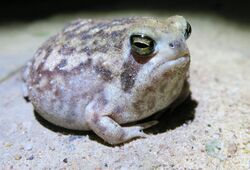Biology:Breviceps adspersus
| Common rain frog | |
|---|---|

| |
| Breviceps adspersus, Limpopo, South Africa. | |
| Scientific classification | |
| Domain: | Eukaryota |
| Kingdom: | Animalia |
| Phylum: | Chordata |
| Class: | Amphibia |
| Order: | Anura |
| Family: | Brevicipitidae |
| Genus: | Breviceps |
| Species: | B. adspersus
|
| Binomial name | |
| Breviceps adspersus Peters, 1882
| |

| |
| Synonyms[2] | |
| |
Breviceps adspersus, also known as common rain frog, bushveld rain frog, and many other vernacular names, is a species of frog in the family Brevicipitidae.[2] It is found in Southern Africa, in Angola, Democratic Republic of the Congo, Namibia, Botswana, Zambia, Zimbabwe, South Africa , Eswatini, and Mozambique.[1][2]
Description
The common rain frog is brownish-green and has a round body and stumpy legs. It cannot jump or swim. Males are 30-47mm in length, while females are usually larger, at 40-60mm.[3]
Behavior and Ecology
The common rain frog inhabits temperate forests and open grasslands of southeast Africa. They spend the dry winter months in burrows and emerge after rain to feed and mate, usually at night. Their diet consists of termites, ants, and other invertebrates.[3] The population of this species is stable, and listed as "locally common".[4]
Reproduction
Since males are too small to grip the female during mating as other frogs do, the male secretes a kind of glue to keep the mating pair together.[3] The stuck-together pair burrow backwards into the soil until they reach the chamber the female has dug 30 cm below the soil surface. There the female lays her eggs. The eggs hatch directly into froglets instead of tadpoles.[4]
References
- ↑ 1.0 1.1 IUCN SSC Amphibian Specialist Group (2013). "Breviceps adspersus". IUCN Red List of Threatened Species 2013: e.T57712A3061969. doi:10.2305/IUCN.UK.2013-2.RLTS.T57712A3061969.en. https://www.iucnredlist.org/species/57712/3061969. Retrieved 16 November 2021.
- ↑ 2.0 2.1 2.2 Frost, Darrel R. (2020). "Breviceps adspersus Peters, 1882". Amphibian Species of the World: An Online Reference. Version 6.1. American Museum of Natural History. doi:10.5531/db.vz.0001. https://amphibiansoftheworld.amnh.org/Amphibia/Anura/Brevicipitidae/Breviceps/Breviceps-adspersus.
- ↑ 3.0 3.1 3.2 Barnes, Keith (2017). "Amphibians". Animals of Kruger National Park. Princeton University Press. pp. 168. ISBN 9781400880690.
- ↑ 4.0 4.1 Burnie, David, ed (2005-09-19). "Amphibians". Animal: The Definitive Visual Guide to the World's Wildlife. New York, New York: Dorling Kindersley, Smithsonian Institution. pp. 456. ISBN 0-7566-1634-4. https://archive.org/details/animal00davi/page/456.
Wikidata ☰ Q2571127 entry
 |


